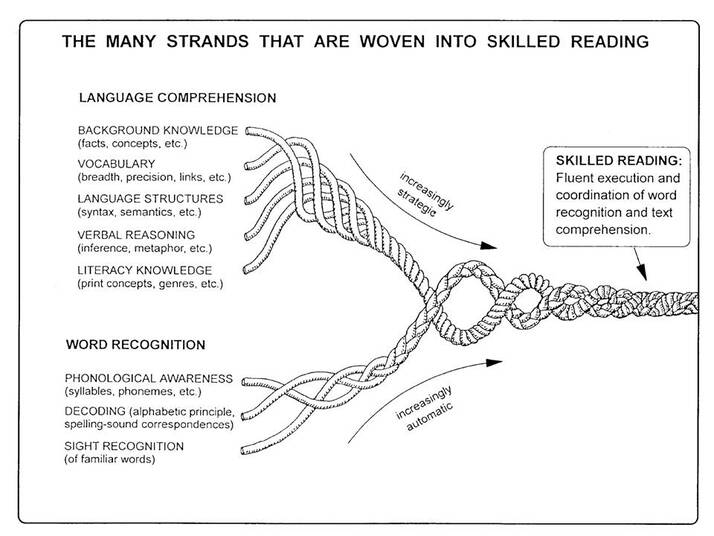Curriculum Series, Part 3 Scarborough's reading rope (2001). Learn it, love it, sleep with a copy under your pillow. Scarborough's reading rope (2001). Learn it, love it, sleep with a copy under your pillow. Lately, I’ve responded to many questions, both online and in-person, about how to choose ELA curriculum. After all, it’s that time of year, when education leaders start thinking about the next school year and how they might improve student outcomes. (At least, I hope that’s what they are thinking about. They probably are not thinking that they have millions of dollars just lying around and new books might be nice. But you never know.) The curriculum selection process can be fraught—you want the best for kids, to make teachers’ lives easier, and to stay in budget. And even with a strong process, you’ll probably find that some people are just going to complain, no matter what you end up with. Still, I’ve learned a few things over the years that can help make the decision a little easier. Get grounded in the evidence In the past (and … probably today, let’s face it), curriculum selection looked like this: the district would put out a bunch of samples provided by publishing companies, invite teachers to look at them and give feedback, and then pick something that looked pretty or provided the best value. Those publishing reps are still out there with their samples, and a proliferation of online tools may catch your eye. With all those cute materials out there, it’s important to focus on what goes into skilled reading: decoding x language comprehension, aka the Simple View of Reading (proposed by Gough and Tunmer in 1986; you can find a good summary in the first third of this article). Scarborough’s “reading rope” (2001) further broke down each of those pieces. When you have the simple view in mind, looking at curricular materials becomes much clearer. Materials that don’t teach decoding systematically and explicitly, or don’t build language comprehension (which includes robust background knowledge), won’t give all children the opportunity to become proficient readers. There are many beautifully-packaged programs that do a bang-up job on one side of the equation, but not the other (and some that don’t do either well). You want to find materials that do both. Use free resources Finding a curriculum that teaches all parts of reading well may sound daunting, particularly if you’re a teacher or leader who has, you know, a few other things on your plate. Luckily, organizations have done the review work for us. EdReports and Louisiana Believes have some of the most complete reports on materials quality. Your state department of education may also have curriculum adoption materials available on their websites, such as rubrics or their own reports. However, be sure to crosscheck these with the sites listed above. I once did a curriculum review for a small charter school, and found that none of the curricula recommended by their state had been rated as aligned to the Common Core State Standards by EdReports. States often have other interests driving their decisions that go beyond educational best practices (as a recent New York Times investigation of textbooks showed). Put together a team Don’t deputize one person to choose the curriculum—and if you are the person who has already been deputized, this advice goes double. Put together a committee that will do the preliminary work of narrowing down choices to two or three, before presenting these to the broader group of stakeholders. Ideally, this team should consist of both new and experienced teachers, administrators, interventionists, and family or community members. Why include the community? Because they will be able to highlight the types of texts and experiences they want for their children. Many curriculum developers are actively working to increase the cultural relevance of their materials, but there is still much work to do in that area. By including community and families, you increase the chances of choosing curricular materials that will provide your students with both windows and mirrors. Make sure administrators are on board. No, really on board. I once participated in a curriculum selection process that was truly teacher-driven; in fact, teachers initiated the process and I supported them as literacy specialist. It was the sort of grassroots change that we often extol in education … and it was ultimately a failure, because even though administrators were brought into the process at various points, they didn’t have the deep understanding of reading science about how kids learn to read. Both your committee and all administrators need to be grounded in what makes great literacy teaching, particularly as this can look much different from the standards-based, skills-focused teaching that works in many other subjects. Unless administrators are prepared to work shoulder-to-shoulder with teachers in implementing a new curriculum, things can get very messy, very quickly. While there’s no easy way to find the right curriculum for your school or district, having a strategic, inclusive process will help set a firm foundation for the really fun part … implementation! (Coming up!) Note: This is the third (really, the fourth) in a series on the practical side of implementing high-quality curricula. Part 1: The Power of a Quality Curriculum Part 2A: Assumptions Part 2B: Another Assumption Part 2C: One More Assumption Part 3: Choosing a Quality Curriculum
0 Comments
Leave a Reply. |
Click the categories below for entries on specific topics.
AuthorCatlin Goodrow, M.A.T Archives
December 2022
Categories
All
|
 RSS Feed
RSS Feed
